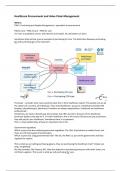Healthcare Procurement and Value Chain Management
Week 1:
PSM = Purchasing and Supply Management = equivalent to procurement
PSM in care = PSM of care + PSM for care
It’s more a qualitative course, with theories and model. No calculations or Excel.
Sometimes they will ask: give an example of purchasing for care. The distinction between purchasing
for and purchasing of is very important.
Purchaser – provider split, many countries have this in their healthcare system. The purple one are all
the citizens of a country, all individuals. If you need healthcare, you go to a healthcare provider (GP,
hospital, physiotherapist, pharmacy). Providers are always organizations, individuals are healthcare
professionals.
Sometimes, we have to directly pay the provider, but often we don’t, because of the healthcare
purchaser (payer), they pay for it. In Dutch healthcare, this is the insurer. Because you pay a premium,
they will pay for your healthcare. Sometimes there is co-payment.
This is a triad relationship, all have an important role in this.
Government regulation;
Which country has the smallest government regulation: The USA, they believe in market forces, but
there are still some governmental bodies.
Which country has a big governmental role? The UK, the NHS is a part of the government and they
regulate the system.
This is what we are calling purchasing of care, they are purchasing the healthcare itself. ‘Inkoop van
zorg / zorginkoop’.
But the providers, like Erasmus MC, they also depend on purchasing processes with other actors, we
call them suppliers. This is part is what we call purchasing for care.
,The upper left block, the subcontractor, some healthcare insurers don’t want to pay all healthcare
providers separately. So, healthcare providers have a contract with a subcontractor, who has a
contract with the insurer. The GP can sometimes be a subcontractor.
The pharmaceutical sector can be a little different. Some insurance companies are getting involved
with purchasing for care. A hospital also has a contract with a pharmaceutical supplier, who also has a
contract with an insurer. So, the insurance company creates a contract with a pharmaceutical
organization, and then told their healthcare providers to buy their stuff at that specific
pharmaceutical supplier.
So, things like these happen.
Picture of the NHS;
Where do you see ‘purchasing for care’?
The boxes: purchasing / procurement department of the hospital and the suppliers of health care
products and support services
Where do you see ‘purchasing of care’?
The boxes: Health Service Commissioner, this is the purchaser negotiating with the hospitals
Purchasing for care; for the rest of this lecture mostly
What does purchasing cover?
‘Anything for which you receive an invoice’
Does the university purchase the lecturer? If the lecturer is part of the organization, on salary, then
no. If the lecturer is external, sending invoices to the university, then it is purchasing.
It covers:
• Goods and services
• Direct (‘bill-of-materials’) and indirect spend
> Volkswagen builds cars, everything that ends up in the car, is direct spend. But, they also
buy electricity or machinery, that is indirect spend.
, • Incidental (“one-off”) and highly routine purchases
> Somethings you buy once, somethings every month for example.
• Customized and standard (“off-the-shelf”) products
> Of-the-shelf, you can’t change it. Suppliers already have the product. Some things you can
customize for yourself.
(The term “product” is often used to mean physical goods as well as services)
Direct / indirect purchasing is sometimes really difficult, specifically for universities and hospitals.
Direct – medical – patient-related spend;
Some stuff is patient related; you could see that as direct. Like medicine, gloves, machinery.
Indirect – non-medical – non-patient-related spend
Some stuff is not patient related, or not medical, we call that indirect. Like cleaning, pencils,
electricity.
What does a hospital purchase more? Direct spend.
> Indirect spend is more standardized, you don’t customize this.
> Direct spend is more customized, sometimes more expansive, could have impact on quality of care,
life of death, that is our primary process. Also, this is where doctors want to be involved. The indirect
spend, doctors don’t care about. So, this spend type will take more time.
> Most of the times, one purchaser in the organization does the whole indirect spend, and multiple
purchasers on direct spend.
Capital expenditure (CAPEX), investment goods → a third one
Accidental, very expensive, purchasing. This is called CAPEX or investment goods. Like an MRI scan, all
the computers or a new building.
In Dutch: alles waar je een afschrijving voor heb. Waar je meerdere jaren rekening mee houdt.
A classification of hospital purchases
They put CAPEX in two different ones, equipment and construction.
They also do something interesting with the direct ones. Why is it interesting to make this distinction?
For high-preference clinical, you have to work more closely with clinicians because it matters on these
products.
Price differences between care providers
, For a 100 different products, in the UK, they analyzed, by looking at an X number of hospitals, the
price differences for each of those 100 products.
So, on the left side, every hospital pays the same for that product. On the right side, there is an
almost 200% difference on that product price. So one hospital pays 200% more than another hospital.
What are reasons for this?
> Economies of scale
> Better negotiators
Purchasing ratio
Purchasing costs can vary from 10-85% of total costs of an organization (this is called the “purchasing
ratio”)
If I look at the total budget of a hospital, how much of that is purchasing? Not everything that a
hospital spends, is purchasing, think of salaries. This percentage changes between organizations and
is called purchasing ratio.
Why have these big brands high purchasing ratio? They are buying all kinds of components, they are
outsourcing.
Where do you think hospitals would be? → Services
Purchasing ratios in healthcare
Purchasing ratios collected by former ZoMa/ HCM students




